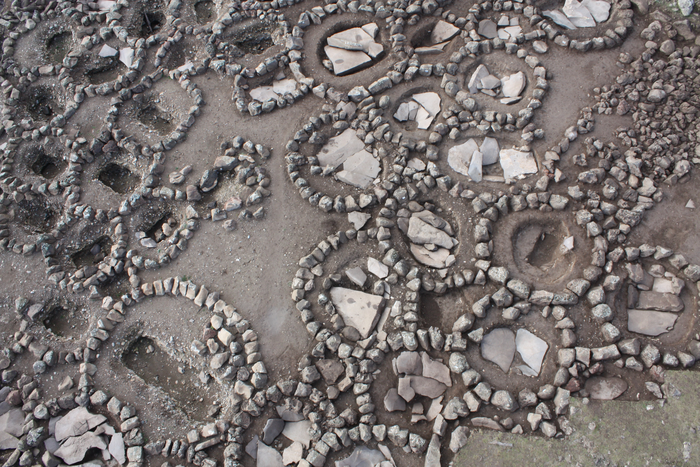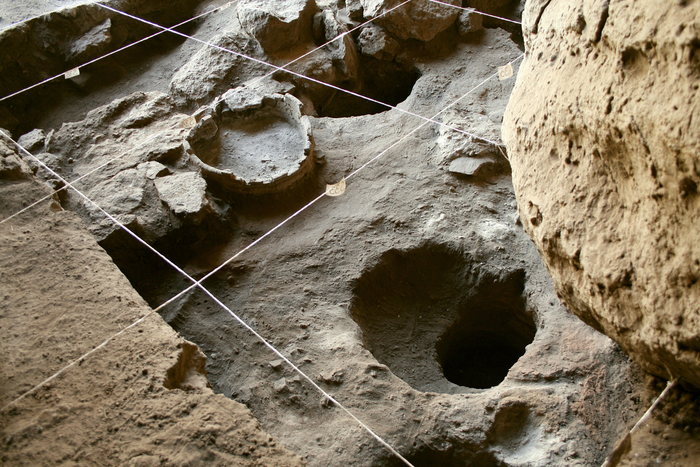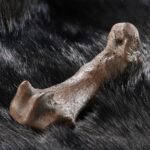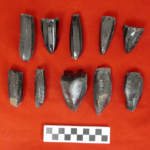The Southern Arc and its lively genetic history
Vast paleogenetic study reveals insights on migration patterns, the expansion of farming and language development from the Caucasus over western Asia and Southern Europe from the early Copper Age until the late middle ages.

In a trio of papers, published simultaneously in the journal Science, Ron Pinhasi from the Department of Evolutionary Anthropology and Human Evolution and Archaeological Sciences (HEAS) at the University of Vienna and Songül Alpaslan-Roodenberg from the University of Vienna and Harvard University, Iosif Lazaridis and David Reich at Harvard University—together with 202 co-authors—report a massive effort of genome-wide sequencing from 727 distinct ancient individuals with which it was possible to test longstanding archaeological, genetic and linguistic hypotheses. They present a systematic picture of the interlinked histories of peoples across the Southern Arc Region from the origins of agriculture, to late medieval times.
In the first paper the international team investigated the homeland and the spread of Anatolian and Indo-European languages. The genetic results suggest that the homeland of the Indo-Anatolian language family was in West Asia, with only secondary dispersals of non-Anatolian Indo-Europeans from the Eurasian steppe. At the first stage, around 7,000-5,000 years ago, people with ancestry from the Caucasus moved west into Anatolia and north into the steppe. Some of these people may have spoken ancestral forms of Anatolian and Indo-European Languages.
All spoken Indo-European languages (e.g., Greek, Armenian and Sanskrit) can be traced back to Yamnaya steppe herders, with Caucasus hunter-gatherer and Eastern hunter-gatherer ancestry, who ~5,000 years ago initiated a chain of migrations across Eurasia. Their southern expansions into the Balkans and Greece and east across the Caucasus into Armenia left a trace in the DNA of the Bronze Age people of the region.
As they expanded, descendants of the Yamnaya herders admixed differentially with the local populations. The emergence of Greek, Paleo-Balkan, and Albanian (Indo-European) languages in Southeastern Europe and the Armenian language in West Asia, formed out of Indo-European speaking migrants from the steppe interacting with local people, and can be traced by different forms of genetic evidence. In Southeastern Europe, the Yamnaya impact was profound and people of practically full Yamnaya ancestry came just after the beginning of the Yamnaya migrations.
Some of the most striking results are found in the core region of the Southern Arc, Anatolia, where the large-scale data paints a rich picture of change—and lack of change—over time.
The results show that in contrast to the Balkans and the Caucasus, Anatolia was hardly impacted by the Yamnaya migrations. No link to the steppe can be established for the speakers of Anatolian languages (e.g. Hittite, Luwian) due to the absence of Eastern hunter-gatherer ancestry in Anatolia, contrasting with all other regions where Indo-European languages were spoken.
In contrast to Anatolia’s surprising impermeability to steppe migrations, the southern Caucasus was affected multiple times including prior to the Yamnaya migrations.

“I did not expect to find out that the Areni 1 Chalcolithic individuals, who were recovered 15 years ago in the excavation I co-led, would derive ancestry from gene flow from the north to parts of the southern Caucasus more than 1,000 years prior to the expansion of the Yamnaya, and that this northern influence would disappear in the region before reappearing a couple of millennia later. This shows that there is a lot more to be discovered through new excavations and fieldwork in the eastern parts of Western Asia”, says Ron Pinhasi.
“Anatolia was home to diverse populations descended from both local hunter-gatherers and eastern populations of the Caucasus, Mesopotamia, and the Levant”, says Songül Alpaslan-Roodenberg. “The people of the Marmara region and of Southeastern Anatolia, of the Black Sea, and the Aegean region all had variations of the same kinds of ancestry”, continues Alpaslan-Roodenberg.
First farming societies and their interactions
The second paper seeks to understand how the world’s earliest Neolithic populations (~12,000 years ago) were formed.
“The genetic results lend support to a scenario of a web of pan-regional contacts between early farming communities. They also provide new evidence that the Neolithic transition was a complex process that did not occur just in one core region, but across Anatolia and the Near East”, says Ron Pinhasi.
It presents the first ancient DNA data for Pre-Pottery Neolithic farmers from the Tigris side of northern Mesopotamia—both in eastern Turkey and in northern Iraq — a prime region of the origins of agriculture. It also presents the first ancient DNA from Pre-Pottery farmers from the island of Cyprus, which witnessed the earliest maritime expansion of farmers from the eastern Mediterranean. It furthermore provides new data for early Neolithic farmers from the Northwest Zagros, along with the first data from Neolithic Armenia. By filling these gaps, the authors could study the genetic history of these societies for which archaeological research documented complex economic and cultural interactions but could not trace mating systems and interactions which do not leave visible material traces. Results reveal admixture of pre-Neolithic sources related to Anatolian, Caucasus, and Levantine hunter-gatherers, and shows that these early farming cultures formed a continuum of ancestry mirroring the geography of West Asia. The results also chart at least two pulses of migration from the Fertile Crescent heartland to the early farmers of Anatolia.
The Historic Period
The third paper reveals how polities of the ancient Mediterranean world preserved contrasts of ancestry since the Bronze Age but were linked by migration. The results show that the ancestry of people who lived around Rome in the Imperial period was almost identical to that of Roman/Byzantine individuals from Anatolia in both their mean and pattern of variation, while Italians prior to the Imperial period had a very different distribution. This suggests that the Roman Empire in both its shorter-lived western part and the longer-lasting eastern part centered on Anatolia had a diverse but similar population plausibly drawn to a substantial extent from Anatolian pre-Imperial sources.
“These results are really surprising as in a Science paper that I co-led in 2019, on the genetic ancestry of individuals from Ancient Rome, we found a cosmopolitan pattern that we thought was unique to Rome. Now we see other regions of the Roman Empire were also just as cosmopolitan as Rome itself”, says Ron Pinhasi.
Please find more information on the studies here.
More research content on the topic of human behaviour can be found in the University of Vienna’s science magazine Rudolphina.
Press release from the University of Vienna.
———————————————————————————————————————————————————-
Ancient DNA provides comprehensive genomic history of the “cradle of Western civilization”
Across three studies, Iosif Lazaridis, David Reich, and colleagues present a comprehensive genomic history of the so-called “Southern Arc,” a region spanning southeastern Europe and Western Asia and long considered to be the “cradle of Western civilization.” The analysis, which examined newly sequenced ancient DNA from more than 700 individuals across the region, reveals a complex population history from the earliest farming cultures to post-Medieval times. Until relatively recently, much of the ancient history of the Southern Arc – stories concerning its people and populations – have been told through archaeological data and the thousands of years of historical accounts and texts from the region. However, innovations in sequencing ancient DNA have provided a new source of historical information. Here, in three separate studies, Lazaridis et al. use ancient DNA from the remains of 777 humans to build a detailed genomic history of the Southern Arc from the Neolithic (~10,000 BCE) to the Ottoman period (~1700 CE). The findings provide an account of complex migrations and population interactions that have shaped the region for thousands of years and suggest that the earlier reliance on modern population history and ancient writings and art have provided an inaccurate picture of early Indo-European cultures.
The first study: “The genetic history of the Southern Arc: a bridge between West Asia and Europe,” presents the new dataset and focuses analysis on the Chalcolithic and Bronze Age (roughly 5000 to 1000 BCE). This analysis revealed large genetic exchanges between the Eurasian Steppe and the Southern Arc and provides new insights into the formation of the Yamnaya steppe pastoralists and the origin of Indo-European language.
The second study: “Ancient DNA from Mesopotamia suggests distinct Pre-Pottery and Pottery Neolithic migrations into Anatolia,” presents the first ancient DNA from Pre-Pottery Neolithic Mesopotamia from the epicenter of the region’s Neolithic Revolution. The findings suggest that the transition between Pre-Pottery and Pottery Neolithic phases of Neolithic Anatolia was associated with two distinct pulses of migration from the Fertile Crescent heartland.
The third study: “A genetic probe into the ancient and medieval history of Southern Europe and West Asia,” focuses on ancient DNA analysis during the period of recorded history in the Southern Arc, elucidating the not-well-understood demographics and geographic origins of groups like the Myceneans, Urartians, and Romans.
“The studies by Lazaridis et al. represent an important milestone for ancient genomic research, providing a rich dataset and diverse observations that will drive the next iteration of interpretations of the human history of West Eurasia,” write Benjamin Arbuckle and Zoe Schwandt in a related Perspective. Although the authors note that Lazaridis et al. have produced an “astounding dataset, unimaginable in its scale just a decade ago,”
Arbuckle and Schwandt highlight the challenges and limitations of the interpretations, suggesting that many of the narratives explored across the three studies reflect a Eurocentric worldview.
Press release from the American Association for the Advancement of Science – AAAS


